GSB014 - Catanza Technologies: Applying Decision Analysis Techniques
VerifiedAdded on 2023/06/11
|24
|5888
|370
Case Study
AI Summary
This case study examines Catanza Technologies' decision regarding the development of a robotic lawnmower (RLM19) using either Electric Wire (EW) or GPS technology. The analysis employs decision tree analysis, Net Present Value (NPV), and sensitivity analysis to determine the optimal choice. The report recommends GPS for companies with a high-risk tolerance due to its higher revenue potential, despite increased risk, and EW for those with a low-risk tolerance due to its lower initial cost and quicker market entry. The analysis highlights the strengths of the process, such as the marketing team's expertise and the availability of probabilities for future events, while also acknowledging limitations, including the need for additional research and data collection to enhance the decision-making process. Ultimately, the study concludes that the choice between GPS and EW depends on Catanza's risk appetite, suggesting further research for companies with moderate risk tolerance.
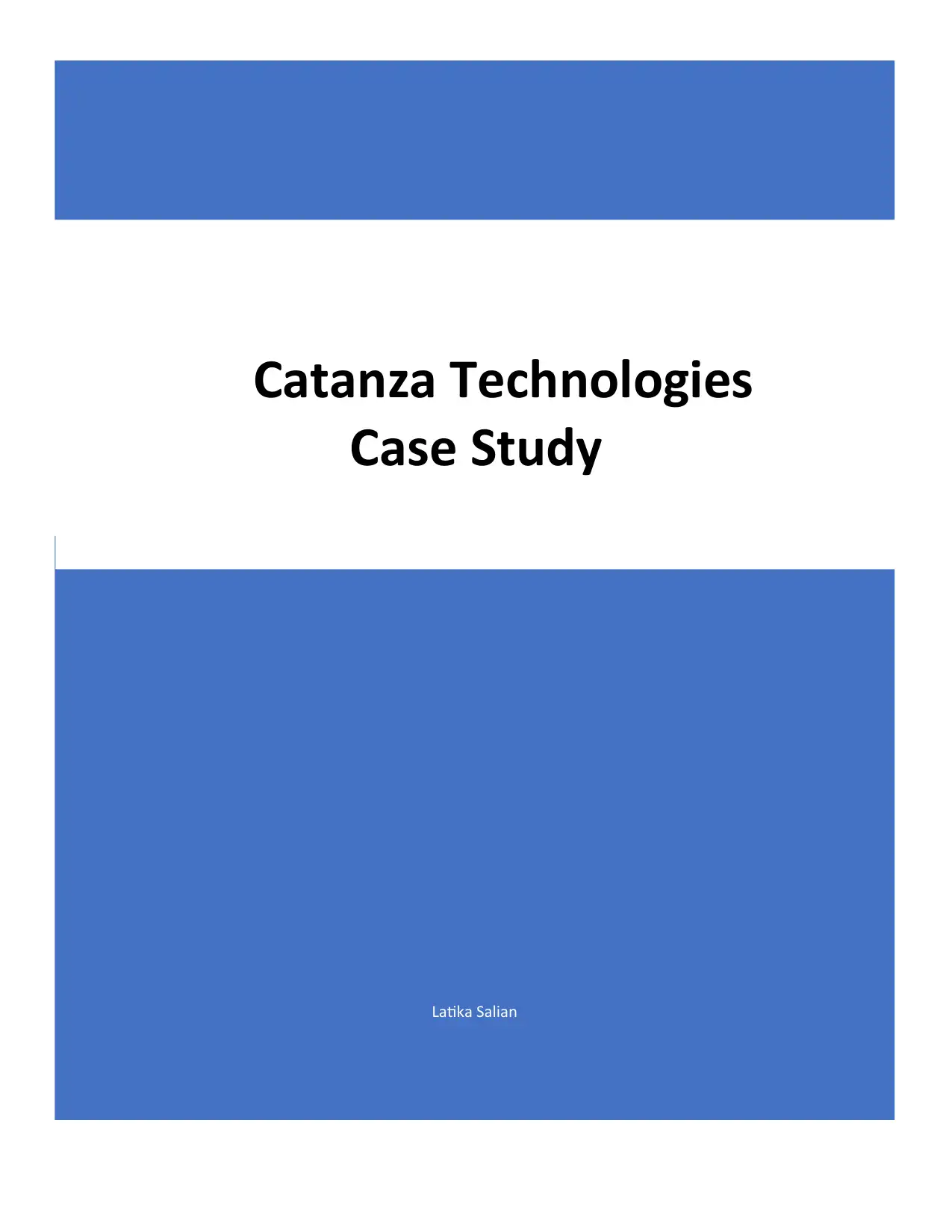
Latika Salian
Catanza Technologies
Case Study
Catanza Technologies
Case Study
Paraphrase This Document
Need a fresh take? Get an instant paraphrase of this document with our AI Paraphraser
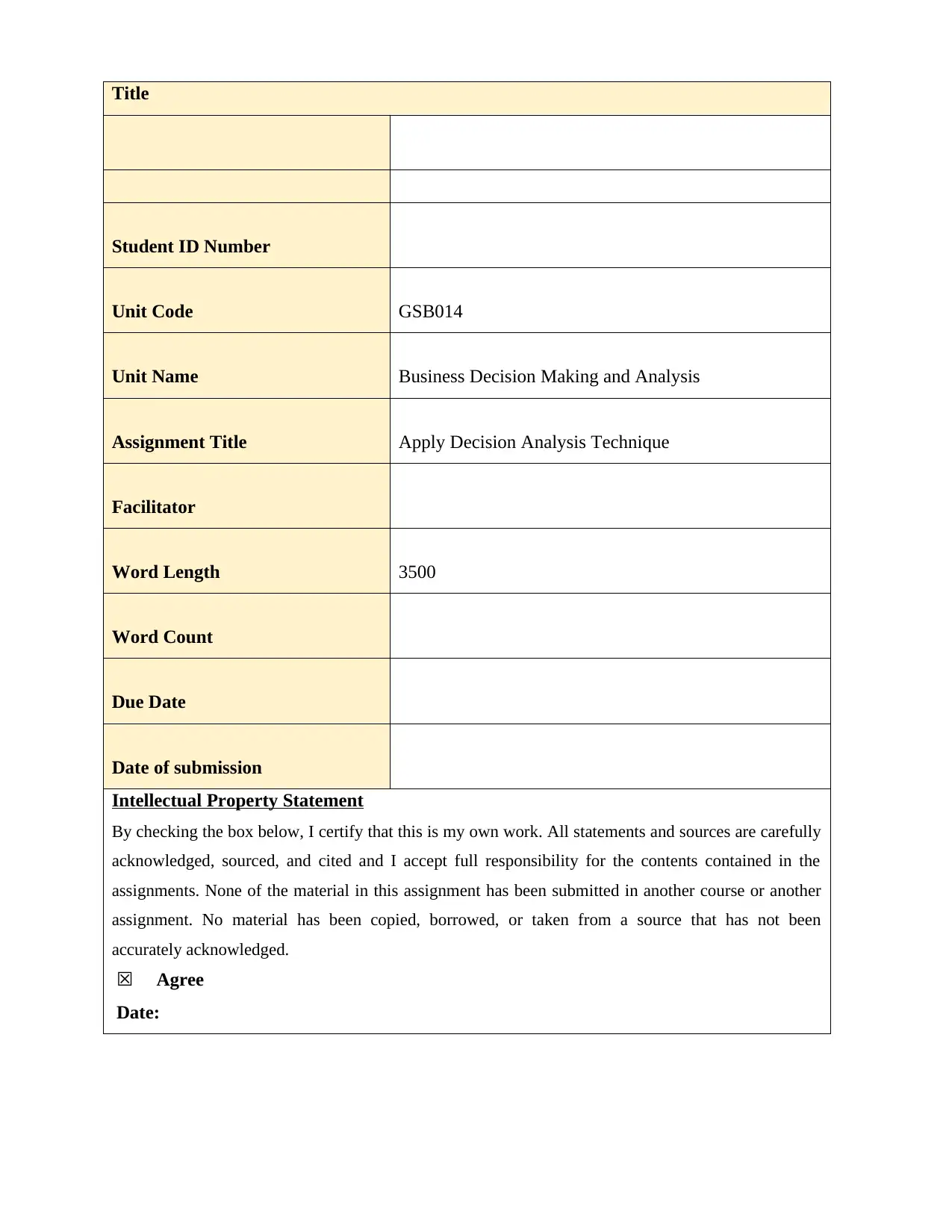
Title
Student ID Number
Unit Code GSB014
Unit Name Business Decision Making and Analysis
Assignment Title Apply Decision Analysis Technique
Facilitator
Word Length 3500
Word Count
Due Date
Date of submission
Intellectual Property Statement
By checking the box below, I certify that this is my own work. All statements and sources are carefully
acknowledged, sourced, and cited and I accept full responsibility for the contents contained in the
assignments. None of the material in this assignment has been submitted in another course or another
assignment. No material has been copied, borrowed, or taken from a source that has not been
accurately acknowledged.
☒ Agree
Date:
Student ID Number
Unit Code GSB014
Unit Name Business Decision Making and Analysis
Assignment Title Apply Decision Analysis Technique
Facilitator
Word Length 3500
Word Count
Due Date
Date of submission
Intellectual Property Statement
By checking the box below, I certify that this is my own work. All statements and sources are carefully
acknowledged, sourced, and cited and I accept full responsibility for the contents contained in the
assignments. None of the material in this assignment has been submitted in another course or another
assignment. No material has been copied, borrowed, or taken from a source that has not been
accurately acknowledged.
☒ Agree
Date:
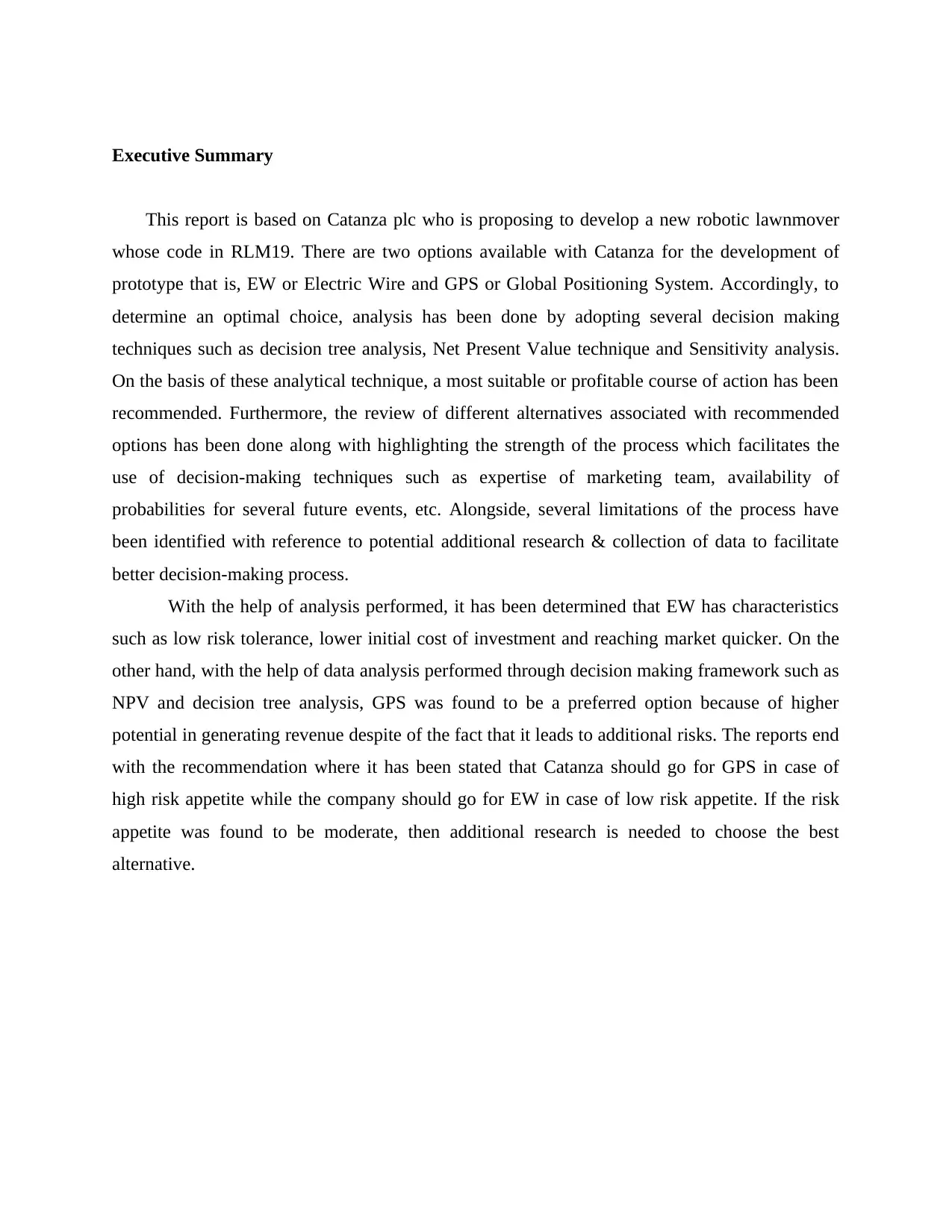
Executive Summary
This report is based on Catanza plc who is proposing to develop a new robotic lawnmover
whose code in RLM19. There are two options available with Catanza for the development of
prototype that is, EW or Electric Wire and GPS or Global Positioning System. Accordingly, to
determine an optimal choice, analysis has been done by adopting several decision making
techniques such as decision tree analysis, Net Present Value technique and Sensitivity analysis.
On the basis of these analytical technique, a most suitable or profitable course of action has been
recommended. Furthermore, the review of different alternatives associated with recommended
options has been done along with highlighting the strength of the process which facilitates the
use of decision-making techniques such as expertise of marketing team, availability of
probabilities for several future events, etc. Alongside, several limitations of the process have
been identified with reference to potential additional research & collection of data to facilitate
better decision-making process.
With the help of analysis performed, it has been determined that EW has characteristics
such as low risk tolerance, lower initial cost of investment and reaching market quicker. On the
other hand, with the help of data analysis performed through decision making framework such as
NPV and decision tree analysis, GPS was found to be a preferred option because of higher
potential in generating revenue despite of the fact that it leads to additional risks. The reports end
with the recommendation where it has been stated that Catanza should go for GPS in case of
high risk appetite while the company should go for EW in case of low risk appetite. If the risk
appetite was found to be moderate, then additional research is needed to choose the best
alternative.
This report is based on Catanza plc who is proposing to develop a new robotic lawnmover
whose code in RLM19. There are two options available with Catanza for the development of
prototype that is, EW or Electric Wire and GPS or Global Positioning System. Accordingly, to
determine an optimal choice, analysis has been done by adopting several decision making
techniques such as decision tree analysis, Net Present Value technique and Sensitivity analysis.
On the basis of these analytical technique, a most suitable or profitable course of action has been
recommended. Furthermore, the review of different alternatives associated with recommended
options has been done along with highlighting the strength of the process which facilitates the
use of decision-making techniques such as expertise of marketing team, availability of
probabilities for several future events, etc. Alongside, several limitations of the process have
been identified with reference to potential additional research & collection of data to facilitate
better decision-making process.
With the help of analysis performed, it has been determined that EW has characteristics
such as low risk tolerance, lower initial cost of investment and reaching market quicker. On the
other hand, with the help of data analysis performed through decision making framework such as
NPV and decision tree analysis, GPS was found to be a preferred option because of higher
potential in generating revenue despite of the fact that it leads to additional risks. The reports end
with the recommendation where it has been stated that Catanza should go for GPS in case of
high risk appetite while the company should go for EW in case of low risk appetite. If the risk
appetite was found to be moderate, then additional research is needed to choose the best
alternative.
⊘ This is a preview!⊘
Do you want full access?
Subscribe today to unlock all pages.

Trusted by 1+ million students worldwide
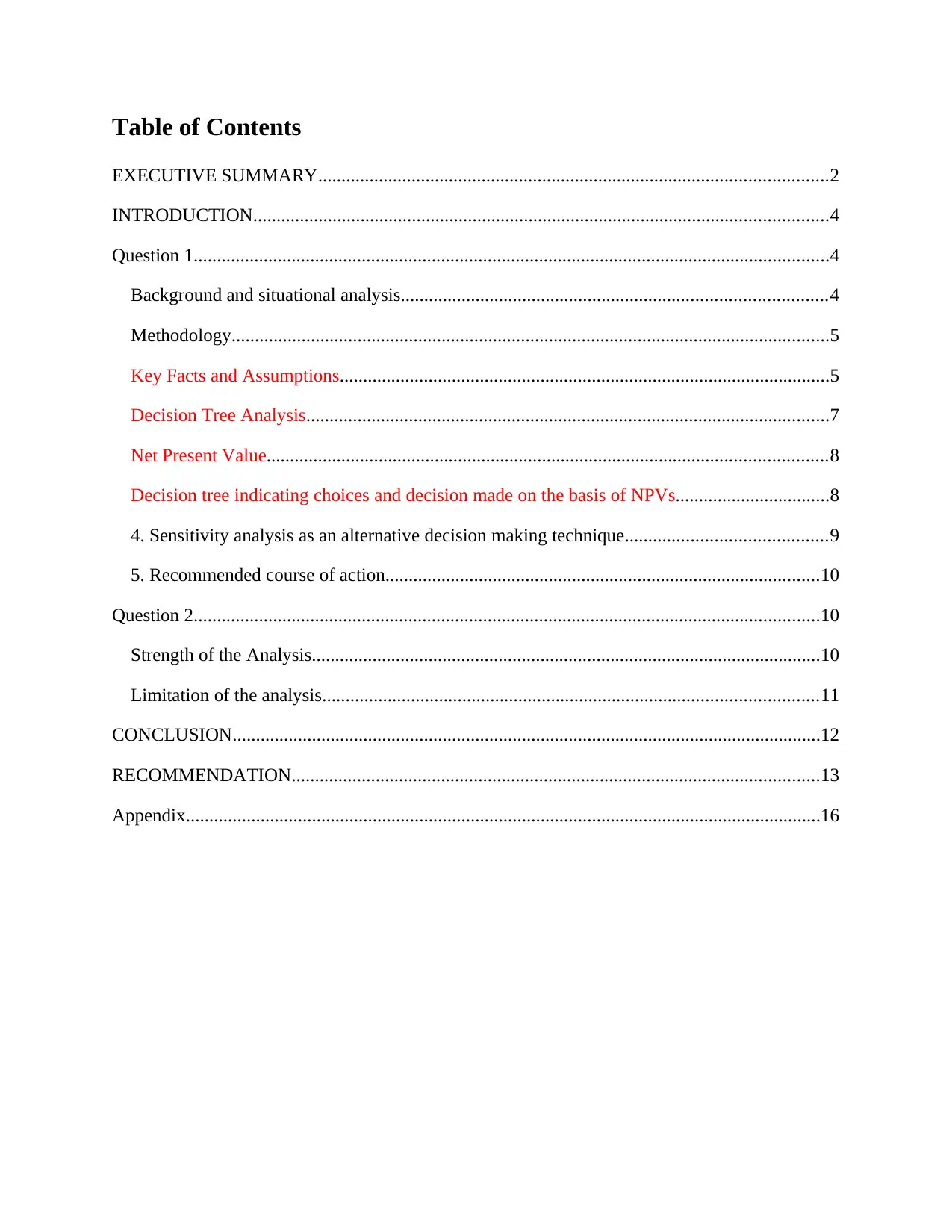
Table of Contents
EXECUTIVE SUMMARY.............................................................................................................2
INTRODUCTION...........................................................................................................................4
Question 1........................................................................................................................................4
Background and situational analysis...........................................................................................4
Methodology................................................................................................................................5
Key Facts and Assumptions.........................................................................................................5
Decision Tree Analysis................................................................................................................7
Net Present Value........................................................................................................................8
Decision tree indicating choices and decision made on the basis of NPVs.................................8
4. Sensitivity analysis as an alternative decision making technique...........................................9
5. Recommended course of action.............................................................................................10
Question 2......................................................................................................................................10
Strength of the Analysis.............................................................................................................10
Limitation of the analysis..........................................................................................................11
CONCLUSION..............................................................................................................................12
RECOMMENDATION.................................................................................................................13
Appendix........................................................................................................................................16
EXECUTIVE SUMMARY.............................................................................................................2
INTRODUCTION...........................................................................................................................4
Question 1........................................................................................................................................4
Background and situational analysis...........................................................................................4
Methodology................................................................................................................................5
Key Facts and Assumptions.........................................................................................................5
Decision Tree Analysis................................................................................................................7
Net Present Value........................................................................................................................8
Decision tree indicating choices and decision made on the basis of NPVs.................................8
4. Sensitivity analysis as an alternative decision making technique...........................................9
5. Recommended course of action.............................................................................................10
Question 2......................................................................................................................................10
Strength of the Analysis.............................................................................................................10
Limitation of the analysis..........................................................................................................11
CONCLUSION..............................................................................................................................12
RECOMMENDATION.................................................................................................................13
Appendix........................................................................................................................................16
Paraphrase This Document
Need a fresh take? Get an instant paraphrase of this document with our AI Paraphraser

Table of Abbreviations and Acronyms
Abbreviation/Acronyms Explanation
Abbreviation/Acronyms Explanation

⊘ This is a preview!⊘
Do you want full access?
Subscribe today to unlock all pages.

Trusted by 1+ million students worldwide
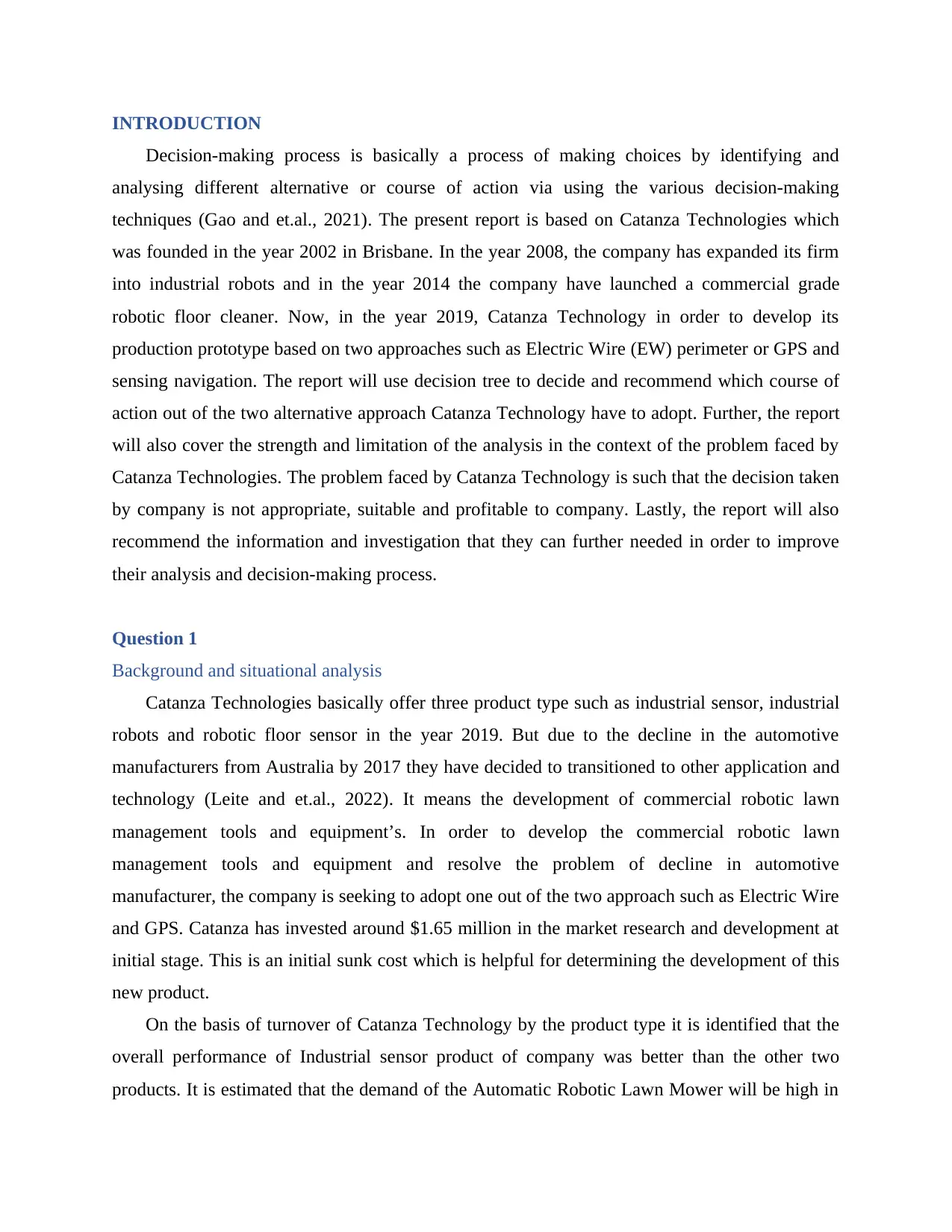
INTRODUCTION
Decision-making process is basically a process of making choices by identifying and
analysing different alternative or course of action via using the various decision-making
techniques (Gao and et.al., 2021). The present report is based on Catanza Technologies which
was founded in the year 2002 in Brisbane. In the year 2008, the company has expanded its firm
into industrial robots and in the year 2014 the company have launched a commercial grade
robotic floor cleaner. Now, in the year 2019, Catanza Technology in order to develop its
production prototype based on two approaches such as Electric Wire (EW) perimeter or GPS and
sensing navigation. The report will use decision tree to decide and recommend which course of
action out of the two alternative approach Catanza Technology have to adopt. Further, the report
will also cover the strength and limitation of the analysis in the context of the problem faced by
Catanza Technologies. The problem faced by Catanza Technology is such that the decision taken
by company is not appropriate, suitable and profitable to company. Lastly, the report will also
recommend the information and investigation that they can further needed in order to improve
their analysis and decision-making process.
Question 1
Background and situational analysis
Catanza Technologies basically offer three product type such as industrial sensor, industrial
robots and robotic floor sensor in the year 2019. But due to the decline in the automotive
manufacturers from Australia by 2017 they have decided to transitioned to other application and
technology (Leite and et.al., 2022). It means the development of commercial robotic lawn
management tools and equipment’s. In order to develop the commercial robotic lawn
management tools and equipment and resolve the problem of decline in automotive
manufacturer, the company is seeking to adopt one out of the two approach such as Electric Wire
and GPS. Catanza has invested around $1.65 million in the market research and development at
initial stage. This is an initial sunk cost which is helpful for determining the development of this
new product.
On the basis of turnover of Catanza Technology by the product type it is identified that the
overall performance of Industrial sensor product of company was better than the other two
products. It is estimated that the demand of the Automatic Robotic Lawn Mower will be high in
Decision-making process is basically a process of making choices by identifying and
analysing different alternative or course of action via using the various decision-making
techniques (Gao and et.al., 2021). The present report is based on Catanza Technologies which
was founded in the year 2002 in Brisbane. In the year 2008, the company has expanded its firm
into industrial robots and in the year 2014 the company have launched a commercial grade
robotic floor cleaner. Now, in the year 2019, Catanza Technology in order to develop its
production prototype based on two approaches such as Electric Wire (EW) perimeter or GPS and
sensing navigation. The report will use decision tree to decide and recommend which course of
action out of the two alternative approach Catanza Technology have to adopt. Further, the report
will also cover the strength and limitation of the analysis in the context of the problem faced by
Catanza Technologies. The problem faced by Catanza Technology is such that the decision taken
by company is not appropriate, suitable and profitable to company. Lastly, the report will also
recommend the information and investigation that they can further needed in order to improve
their analysis and decision-making process.
Question 1
Background and situational analysis
Catanza Technologies basically offer three product type such as industrial sensor, industrial
robots and robotic floor sensor in the year 2019. But due to the decline in the automotive
manufacturers from Australia by 2017 they have decided to transitioned to other application and
technology (Leite and et.al., 2022). It means the development of commercial robotic lawn
management tools and equipment’s. In order to develop the commercial robotic lawn
management tools and equipment and resolve the problem of decline in automotive
manufacturer, the company is seeking to adopt one out of the two approach such as Electric Wire
and GPS. Catanza has invested around $1.65 million in the market research and development at
initial stage. This is an initial sunk cost which is helpful for determining the development of this
new product.
On the basis of turnover of Catanza Technology by the product type it is identified that the
overall performance of Industrial sensor product of company was better than the other two
products. It is estimated that the demand of the Automatic Robotic Lawn Mower will be high in
Paraphrase This Document
Need a fresh take? Get an instant paraphrase of this document with our AI Paraphraser
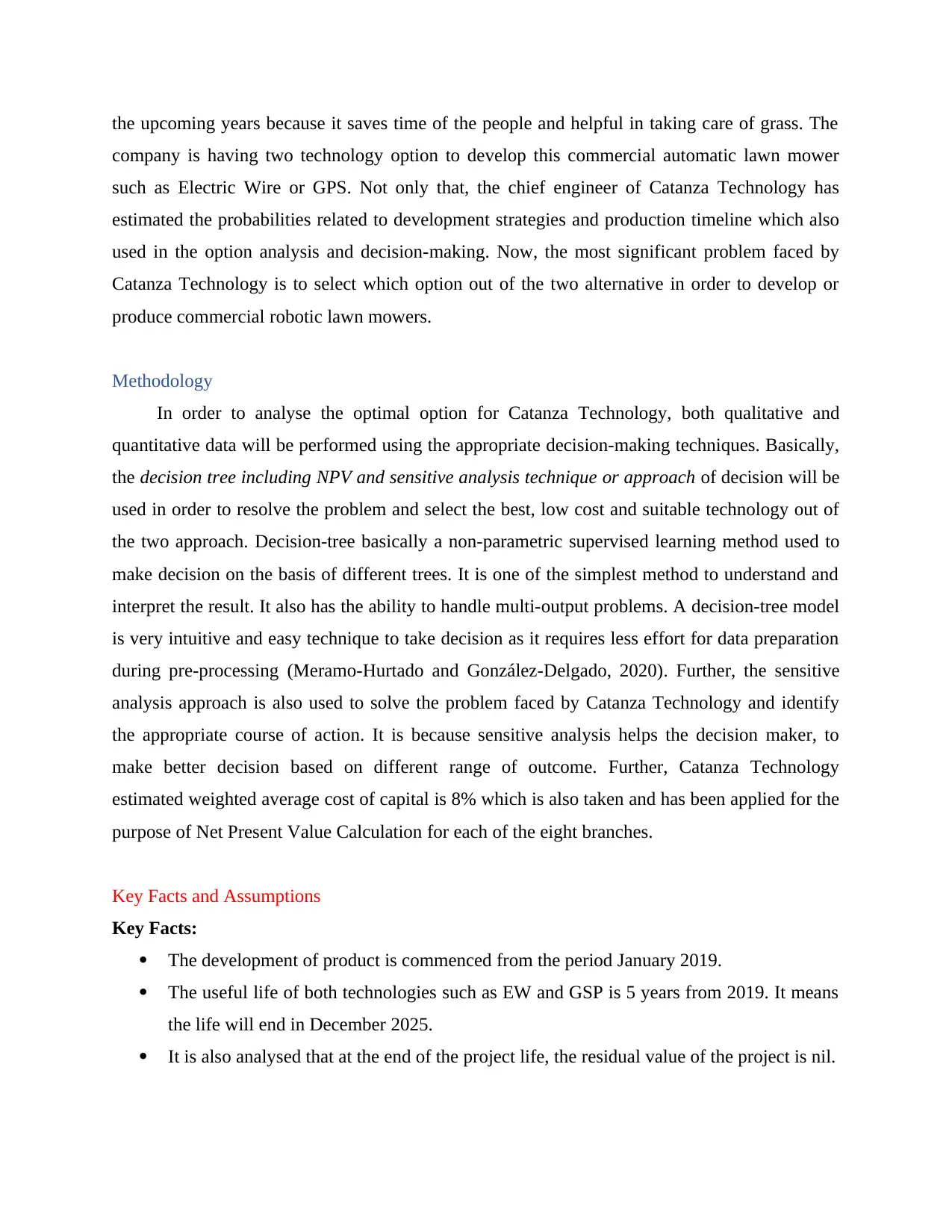
the upcoming years because it saves time of the people and helpful in taking care of grass. The
company is having two technology option to develop this commercial automatic lawn mower
such as Electric Wire or GPS. Not only that, the chief engineer of Catanza Technology has
estimated the probabilities related to development strategies and production timeline which also
used in the option analysis and decision-making. Now, the most significant problem faced by
Catanza Technology is to select which option out of the two alternative in order to develop or
produce commercial robotic lawn mowers.
Methodology
In order to analyse the optimal option for Catanza Technology, both qualitative and
quantitative data will be performed using the appropriate decision-making techniques. Basically,
the decision tree including NPV and sensitive analysis technique or approach of decision will be
used in order to resolve the problem and select the best, low cost and suitable technology out of
the two approach. Decision-tree basically a non-parametric supervised learning method used to
make decision on the basis of different trees. It is one of the simplest method to understand and
interpret the result. It also has the ability to handle multi-output problems. A decision-tree model
is very intuitive and easy technique to take decision as it requires less effort for data preparation
during pre-processing (Meramo-Hurtado and González-Delgado, 2020) . Further, the sensitive
analysis approach is also used to solve the problem faced by Catanza Technology and identify
the appropriate course of action. It is because sensitive analysis helps the decision maker, to
make better decision based on different range of outcome. Further, Catanza Technology
estimated weighted average cost of capital is 8% which is also taken and has been applied for the
purpose of Net Present Value Calculation for each of the eight branches.
Key Facts and Assumptions
Key Facts:
The development of product is commenced from the period January 2019.
The useful life of both technologies such as EW and GSP is 5 years from 2019. It means
the life will end in December 2025.
It is also analysed that at the end of the project life, the residual value of the project is nil.
company is having two technology option to develop this commercial automatic lawn mower
such as Electric Wire or GPS. Not only that, the chief engineer of Catanza Technology has
estimated the probabilities related to development strategies and production timeline which also
used in the option analysis and decision-making. Now, the most significant problem faced by
Catanza Technology is to select which option out of the two alternative in order to develop or
produce commercial robotic lawn mowers.
Methodology
In order to analyse the optimal option for Catanza Technology, both qualitative and
quantitative data will be performed using the appropriate decision-making techniques. Basically,
the decision tree including NPV and sensitive analysis technique or approach of decision will be
used in order to resolve the problem and select the best, low cost and suitable technology out of
the two approach. Decision-tree basically a non-parametric supervised learning method used to
make decision on the basis of different trees. It is one of the simplest method to understand and
interpret the result. It also has the ability to handle multi-output problems. A decision-tree model
is very intuitive and easy technique to take decision as it requires less effort for data preparation
during pre-processing (Meramo-Hurtado and González-Delgado, 2020) . Further, the sensitive
analysis approach is also used to solve the problem faced by Catanza Technology and identify
the appropriate course of action. It is because sensitive analysis helps the decision maker, to
make better decision based on different range of outcome. Further, Catanza Technology
estimated weighted average cost of capital is 8% which is also taken and has been applied for the
purpose of Net Present Value Calculation for each of the eight branches.
Key Facts and Assumptions
Key Facts:
The development of product is commenced from the period January 2019.
The useful life of both technologies such as EW and GSP is 5 years from 2019. It means
the life will end in December 2025.
It is also analysed that at the end of the project life, the residual value of the project is nil.
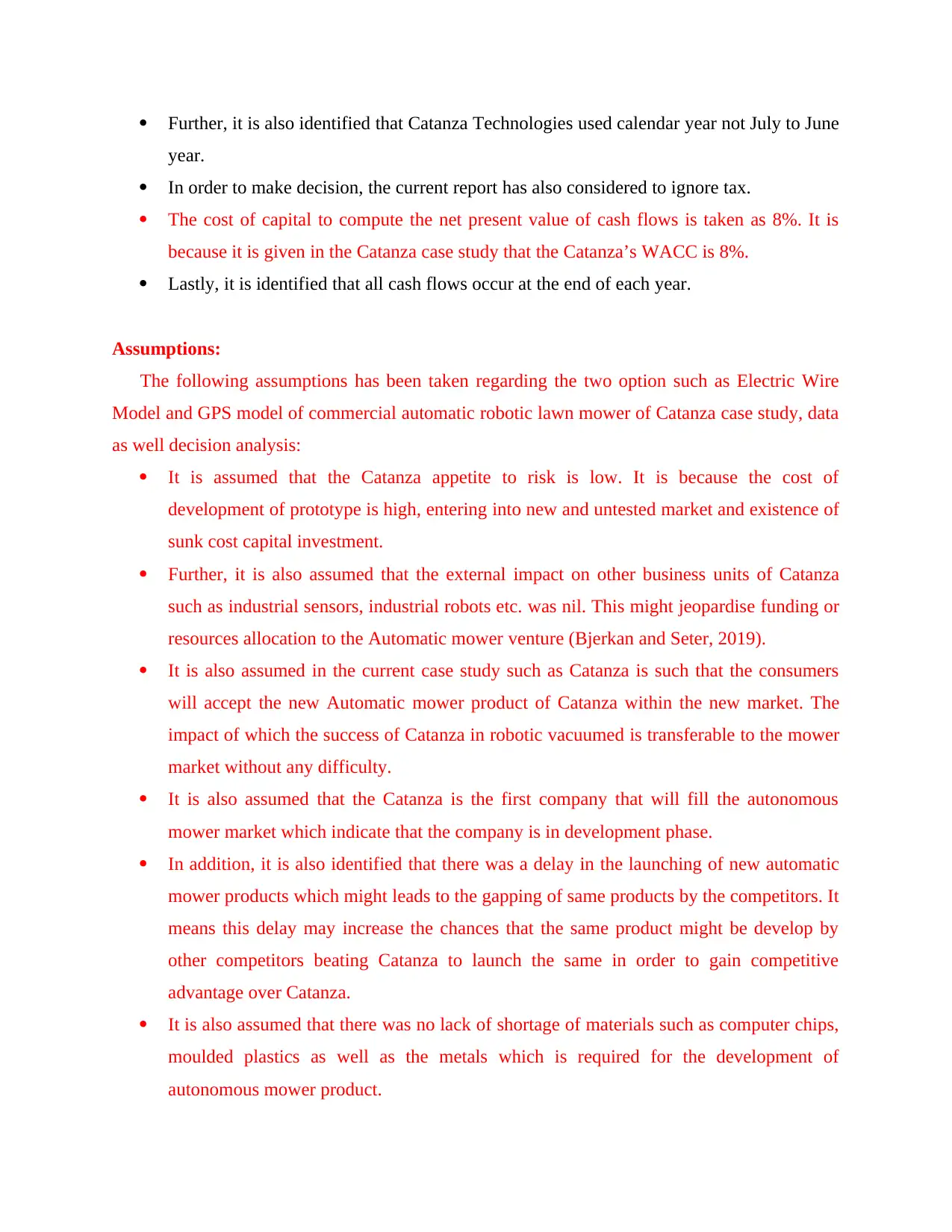
Further, it is also identified that Catanza Technologies used calendar year not July to June
year.
In order to make decision, the current report has also considered to ignore tax.
The cost of capital to compute the net present value of cash flows is taken as 8%. It is
because it is given in the Catanza case study that the Catanza’s WACC is 8%.
Lastly, it is identified that all cash flows occur at the end of each year.
Assumptions:
The following assumptions has been taken regarding the two option such as Electric Wire
Model and GPS model of commercial automatic robotic lawn mower of Catanza case study, data
as well decision analysis:
It is assumed that the Catanza appetite to risk is low. It is because the cost of
development of prototype is high, entering into new and untested market and existence of
sunk cost capital investment.
Further, it is also assumed that the external impact on other business units of Catanza
such as industrial sensors, industrial robots etc. was nil. This might jeopardise funding or
resources allocation to the Automatic mower venture (Bjerkan and Seter, 2019).
It is also assumed in the current case study such as Catanza is such that the consumers
will accept the new Automatic mower product of Catanza within the new market. The
impact of which the success of Catanza in robotic vacuumed is transferable to the mower
market without any difficulty.
It is also assumed that the Catanza is the first company that will fill the autonomous
mower market which indicate that the company is in development phase.
In addition, it is also identified that there was a delay in the launching of new automatic
mower products which might leads to the gapping of same products by the competitors. It
means this delay may increase the chances that the same product might be develop by
other competitors beating Catanza to launch the same in order to gain competitive
advantage over Catanza.
It is also assumed that there was no lack of shortage of materials such as computer chips,
moulded plastics as well as the metals which is required for the development of
autonomous mower product.
year.
In order to make decision, the current report has also considered to ignore tax.
The cost of capital to compute the net present value of cash flows is taken as 8%. It is
because it is given in the Catanza case study that the Catanza’s WACC is 8%.
Lastly, it is identified that all cash flows occur at the end of each year.
Assumptions:
The following assumptions has been taken regarding the two option such as Electric Wire
Model and GPS model of commercial automatic robotic lawn mower of Catanza case study, data
as well decision analysis:
It is assumed that the Catanza appetite to risk is low. It is because the cost of
development of prototype is high, entering into new and untested market and existence of
sunk cost capital investment.
Further, it is also assumed that the external impact on other business units of Catanza
such as industrial sensors, industrial robots etc. was nil. This might jeopardise funding or
resources allocation to the Automatic mower venture (Bjerkan and Seter, 2019).
It is also assumed in the current case study such as Catanza is such that the consumers
will accept the new Automatic mower product of Catanza within the new market. The
impact of which the success of Catanza in robotic vacuumed is transferable to the mower
market without any difficulty.
It is also assumed that the Catanza is the first company that will fill the autonomous
mower market which indicate that the company is in development phase.
In addition, it is also identified that there was a delay in the launching of new automatic
mower products which might leads to the gapping of same products by the competitors. It
means this delay may increase the chances that the same product might be develop by
other competitors beating Catanza to launch the same in order to gain competitive
advantage over Catanza.
It is also assumed that there was no lack of shortage of materials such as computer chips,
moulded plastics as well as the metals which is required for the development of
autonomous mower product.
⊘ This is a preview!⊘
Do you want full access?
Subscribe today to unlock all pages.

Trusted by 1+ million students worldwide
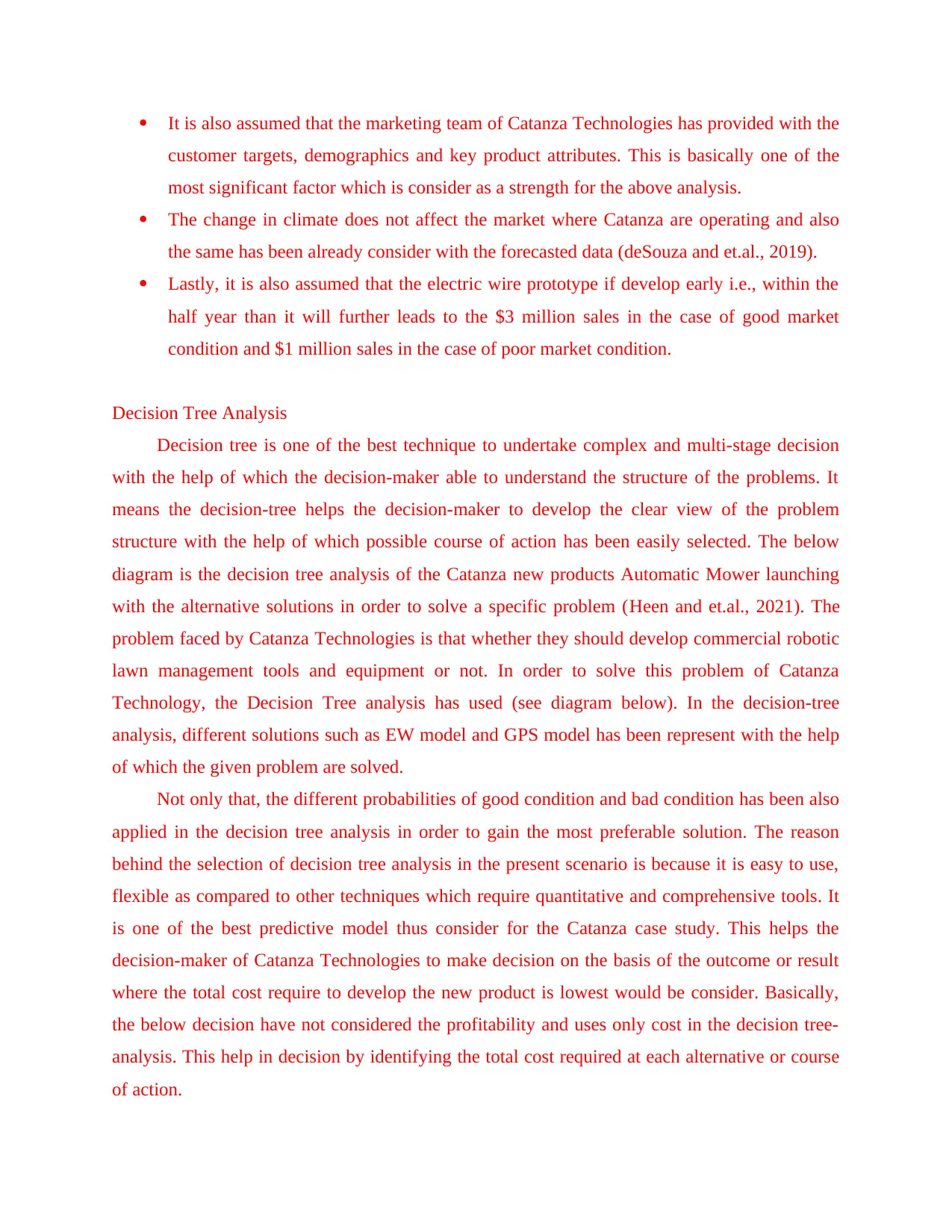
It is also assumed that the marketing team of Catanza Technologies has provided with the
customer targets, demographics and key product attributes. This is basically one of the
most significant factor which is consider as a strength for the above analysis.
The change in climate does not affect the market where Catanza are operating and also
the same has been already consider with the forecasted data (deSouza and et.al., 2019).
Lastly, it is also assumed that the electric wire prototype if develop early i.e., within the
half year than it will further leads to the $3 million sales in the case of good market
condition and $1 million sales in the case of poor market condition.
Decision Tree Analysis
Decision tree is one of the best technique to undertake complex and multi-stage decision
with the help of which the decision-maker able to understand the structure of the problems. It
means the decision-tree helps the decision-maker to develop the clear view of the problem
structure with the help of which possible course of action has been easily selected. The below
diagram is the decision tree analysis of the Catanza new products Automatic Mower launching
with the alternative solutions in order to solve a specific problem (Heen and et.al., 2021). The
problem faced by Catanza Technologies is that whether they should develop commercial robotic
lawn management tools and equipment or not. In order to solve this problem of Catanza
Technology, the Decision Tree analysis has used (see diagram below). In the decision-tree
analysis, different solutions such as EW model and GPS model has been represent with the help
of which the given problem are solved.
Not only that, the different probabilities of good condition and bad condition has been also
applied in the decision tree analysis in order to gain the most preferable solution. The reason
behind the selection of decision tree analysis in the present scenario is because it is easy to use,
flexible as compared to other techniques which require quantitative and comprehensive tools. It
is one of the best predictive model thus consider for the Catanza case study. This helps the
decision-maker of Catanza Technologies to make decision on the basis of the outcome or result
where the total cost require to develop the new product is lowest would be consider. Basically,
the below decision have not considered the profitability and uses only cost in the decision tree-
analysis. This help in decision by identifying the total cost required at each alternative or course
of action.
customer targets, demographics and key product attributes. This is basically one of the
most significant factor which is consider as a strength for the above analysis.
The change in climate does not affect the market where Catanza are operating and also
the same has been already consider with the forecasted data (deSouza and et.al., 2019).
Lastly, it is also assumed that the electric wire prototype if develop early i.e., within the
half year than it will further leads to the $3 million sales in the case of good market
condition and $1 million sales in the case of poor market condition.
Decision Tree Analysis
Decision tree is one of the best technique to undertake complex and multi-stage decision
with the help of which the decision-maker able to understand the structure of the problems. It
means the decision-tree helps the decision-maker to develop the clear view of the problem
structure with the help of which possible course of action has been easily selected. The below
diagram is the decision tree analysis of the Catanza new products Automatic Mower launching
with the alternative solutions in order to solve a specific problem (Heen and et.al., 2021). The
problem faced by Catanza Technologies is that whether they should develop commercial robotic
lawn management tools and equipment or not. In order to solve this problem of Catanza
Technology, the Decision Tree analysis has used (see diagram below). In the decision-tree
analysis, different solutions such as EW model and GPS model has been represent with the help
of which the given problem are solved.
Not only that, the different probabilities of good condition and bad condition has been also
applied in the decision tree analysis in order to gain the most preferable solution. The reason
behind the selection of decision tree analysis in the present scenario is because it is easy to use,
flexible as compared to other techniques which require quantitative and comprehensive tools. It
is one of the best predictive model thus consider for the Catanza case study. This helps the
decision-maker of Catanza Technologies to make decision on the basis of the outcome or result
where the total cost require to develop the new product is lowest would be consider. Basically,
the below decision have not considered the profitability and uses only cost in the decision tree-
analysis. This help in decision by identifying the total cost required at each alternative or course
of action.
Paraphrase This Document
Need a fresh take? Get an instant paraphrase of this document with our AI Paraphraser
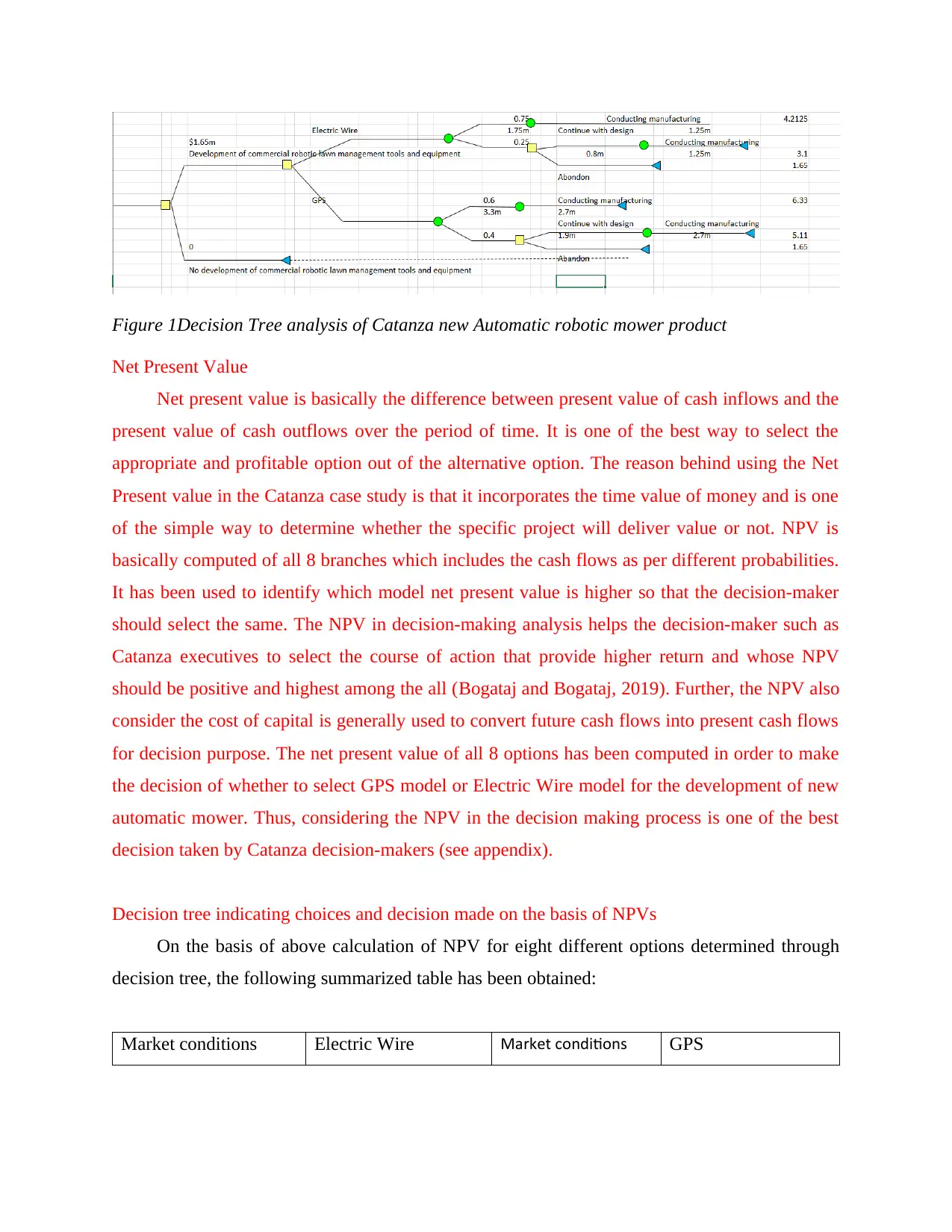
Figure 1Decision Tree analysis of Catanza new Automatic robotic mower product
Net Present Value
Net present value is basically the difference between present value of cash inflows and the
present value of cash outflows over the period of time. It is one of the best way to select the
appropriate and profitable option out of the alternative option. The reason behind using the Net
Present value in the Catanza case study is that it incorporates the time value of money and is one
of the simple way to determine whether the specific project will deliver value or not. NPV is
basically computed of all 8 branches which includes the cash flows as per different probabilities.
It has been used to identify which model net present value is higher so that the decision-maker
should select the same. The NPV in decision-making analysis helps the decision-maker such as
Catanza executives to select the course of action that provide higher return and whose NPV
should be positive and highest among the all (Bogataj and Bogataj, 2019). Further, the NPV also
consider the cost of capital is generally used to convert future cash flows into present cash flows
for decision purpose. The net present value of all 8 options has been computed in order to make
the decision of whether to select GPS model or Electric Wire model for the development of new
automatic mower. Thus, considering the NPV in the decision making process is one of the best
decision taken by Catanza decision-makers (see appendix).
Decision tree indicating choices and decision made on the basis of NPVs
On the basis of above calculation of NPV for eight different options determined through
decision tree, the following summarized table has been obtained:
Market conditions Electric Wire Market conditions GPS
Net Present Value
Net present value is basically the difference between present value of cash inflows and the
present value of cash outflows over the period of time. It is one of the best way to select the
appropriate and profitable option out of the alternative option. The reason behind using the Net
Present value in the Catanza case study is that it incorporates the time value of money and is one
of the simple way to determine whether the specific project will deliver value or not. NPV is
basically computed of all 8 branches which includes the cash flows as per different probabilities.
It has been used to identify which model net present value is higher so that the decision-maker
should select the same. The NPV in decision-making analysis helps the decision-maker such as
Catanza executives to select the course of action that provide higher return and whose NPV
should be positive and highest among the all (Bogataj and Bogataj, 2019). Further, the NPV also
consider the cost of capital is generally used to convert future cash flows into present cash flows
for decision purpose. The net present value of all 8 options has been computed in order to make
the decision of whether to select GPS model or Electric Wire model for the development of new
automatic mower. Thus, considering the NPV in the decision making process is one of the best
decision taken by Catanza decision-makers (see appendix).
Decision tree indicating choices and decision made on the basis of NPVs
On the basis of above calculation of NPV for eight different options determined through
decision tree, the following summarized table has been obtained:
Market conditions Electric Wire Market conditions GPS
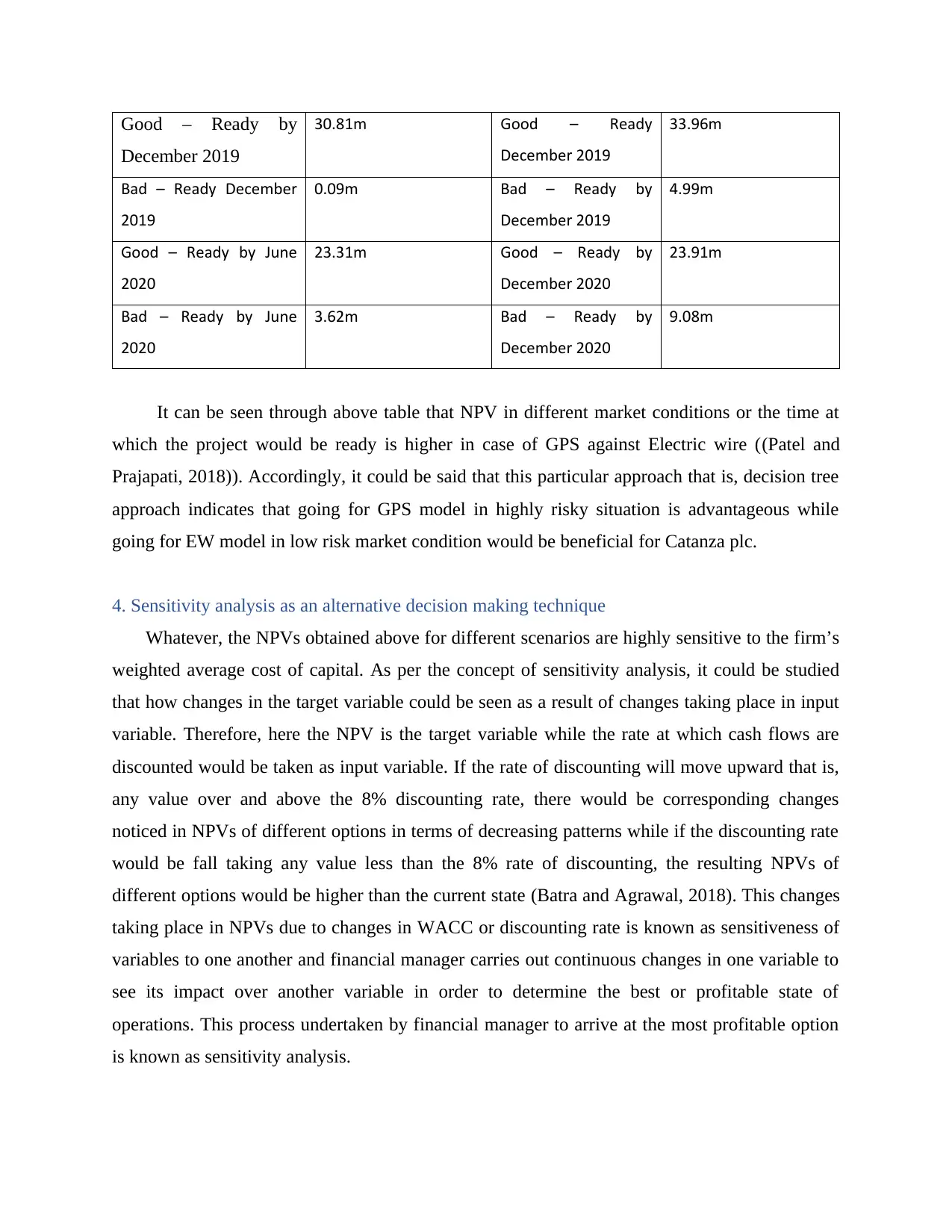
Good – Ready by
December 2019
30.81m Good – Ready
December 2019
33.96m
Bad – Ready December
2019
0.09m Bad – Ready by
December 2019
4.99m
Good – Ready by June
2020
23.31m Good – Ready by
December 2020
23.91m
Bad – Ready by June
2020
3.62m Bad – Ready by
December 2020
9.08m
It can be seen through above table that NPV in different market conditions or the time at
which the project would be ready is higher in case of GPS against Electric wire ((Patel and
Prajapati, 2018)). Accordingly, it could be said that this particular approach that is, decision tree
approach indicates that going for GPS model in highly risky situation is advantageous while
going for EW model in low risk market condition would be beneficial for Catanza plc.
4. Sensitivity analysis as an alternative decision making technique
Whatever, the NPVs obtained above for different scenarios are highly sensitive to the firm’s
weighted average cost of capital. As per the concept of sensitivity analysis, it could be studied
that how changes in the target variable could be seen as a result of changes taking place in input
variable. Therefore, here the NPV is the target variable while the rate at which cash flows are
discounted would be taken as input variable. If the rate of discounting will move upward that is,
any value over and above the 8% discounting rate, there would be corresponding changes
noticed in NPVs of different options in terms of decreasing patterns while if the discounting rate
would be fall taking any value less than the 8% rate of discounting, the resulting NPVs of
different options would be higher than the current state (Batra and Agrawal, 2018). This changes
taking place in NPVs due to changes in WACC or discounting rate is known as sensitiveness of
variables to one another and financial manager carries out continuous changes in one variable to
see its impact over another variable in order to determine the best or profitable state of
operations. This process undertaken by financial manager to arrive at the most profitable option
is known as sensitivity analysis.
December 2019
30.81m Good – Ready
December 2019
33.96m
Bad – Ready December
2019
0.09m Bad – Ready by
December 2019
4.99m
Good – Ready by June
2020
23.31m Good – Ready by
December 2020
23.91m
Bad – Ready by June
2020
3.62m Bad – Ready by
December 2020
9.08m
It can be seen through above table that NPV in different market conditions or the time at
which the project would be ready is higher in case of GPS against Electric wire ((Patel and
Prajapati, 2018)). Accordingly, it could be said that this particular approach that is, decision tree
approach indicates that going for GPS model in highly risky situation is advantageous while
going for EW model in low risk market condition would be beneficial for Catanza plc.
4. Sensitivity analysis as an alternative decision making technique
Whatever, the NPVs obtained above for different scenarios are highly sensitive to the firm’s
weighted average cost of capital. As per the concept of sensitivity analysis, it could be studied
that how changes in the target variable could be seen as a result of changes taking place in input
variable. Therefore, here the NPV is the target variable while the rate at which cash flows are
discounted would be taken as input variable. If the rate of discounting will move upward that is,
any value over and above the 8% discounting rate, there would be corresponding changes
noticed in NPVs of different options in terms of decreasing patterns while if the discounting rate
would be fall taking any value less than the 8% rate of discounting, the resulting NPVs of
different options would be higher than the current state (Batra and Agrawal, 2018). This changes
taking place in NPVs due to changes in WACC or discounting rate is known as sensitiveness of
variables to one another and financial manager carries out continuous changes in one variable to
see its impact over another variable in order to determine the best or profitable state of
operations. This process undertaken by financial manager to arrive at the most profitable option
is known as sensitivity analysis.
⊘ This is a preview!⊘
Do you want full access?
Subscribe today to unlock all pages.

Trusted by 1+ million students worldwide
1 out of 24
Related Documents
Your All-in-One AI-Powered Toolkit for Academic Success.
+13062052269
info@desklib.com
Available 24*7 on WhatsApp / Email
![[object Object]](/_next/static/media/star-bottom.7253800d.svg)
Unlock your academic potential
Copyright © 2020–2025 A2Z Services. All Rights Reserved. Developed and managed by ZUCOL.





